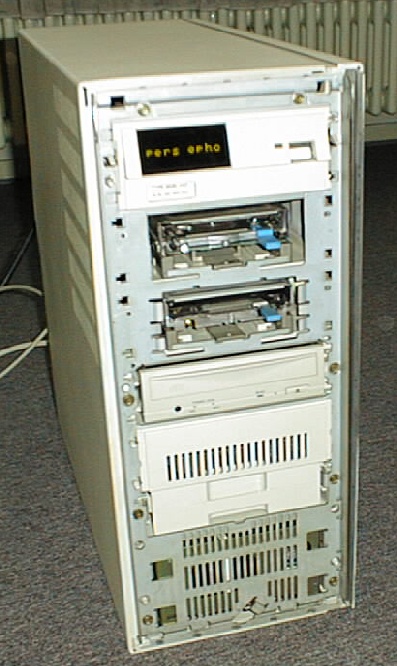
Click here or click onto the photo for a full size version of this picture.
Welcome to the King-Class of PS/2 Systems! You aren't a real collector of PS/2 systems until you have a Model 95...
The Model 95 is the largest 'pure' Microchannel machine built by IBM. It uses the same case as the Model 85, but the innards are substantially different. The outer 'indication' for a Model 95 is the diagnostic LED display. It has 8 alphanumeric digits and is freely programmable via a set of I/O ports. The BIOS will display diagnostic codes and error numbers during startup, but afterwards you are free to do with it what you want...for example, OS/2 uses the rightmost digit as a hard disk access indicator. This makes sense because the first generation of 95's (IBM model number 8595-...) like this one lacked a separate HDD LED. We will later see how you can add one :-) I personally run Linux on this machine and wrote a script-driven tool that regularly displays some system statistics.
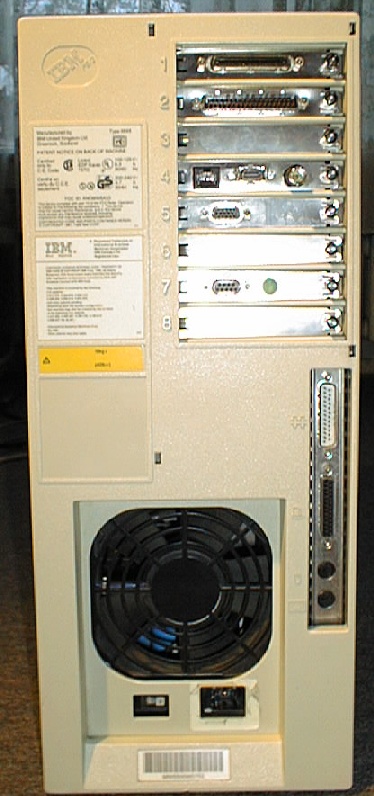
Click here or click onto the photo for
a full size version of this picture.
The planar board offers space for 8 full-length 32-bit MCA cards. The 8595 models use an earlier version of the planar that only offers one serial and one parallel port (later ones had two of each). Really impressive ist the fan of the 400W power supply which is in best tradition of the Model 60/80's giant fan - when you hear that IBM always constructs machines for a minimum lifetime of 10 years, you really believe it when you see this....
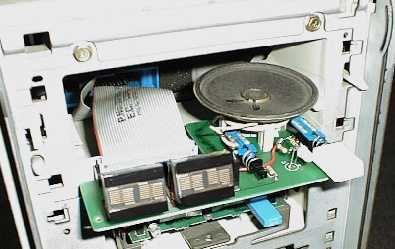
Click here or click onto the photo for
a full size version of this picture.
This is a detail photo of the operator panel. The additional second pushbutton is an artifact since this panel was originally constructed for a different IBM machine - it has no meaning for the 95, but it comes in handy when the power switch breaks and you need a replacement. This photo also shows the modification that replaces the green power LED with a Duo LED that blinks red during disk accesses. The circuitry is simple since the HD access signal is already present on the board. The modification is described in detail on the page mentioned on the right side of this page.
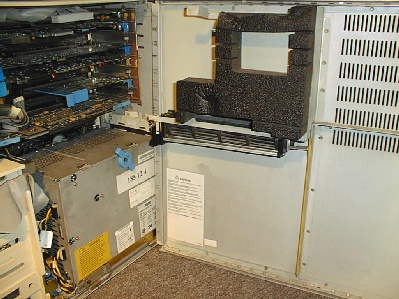
Click here or click onto the photo for
a full size version of this picture.
If you also have to deal with standard PCs, you probably also know the problems linked with the so-called 'CPU fans' - those tiny fans screwed onto the CPU's heat sink to fix the thermal problems of a misdesigned Noname case and which get stuck twice a year. The 95 uses a large radial fan in a side cover. It is directly targeted at the processor board and allows to run the original 486DX33 CPU without any heatsink! I now have a DX2-66 in the machine and a small passive cooler is sufficient to avoid any heatup :-) By the way, the side fan is the reason why one should't run the machine for more than a few minutes with the cover removed.
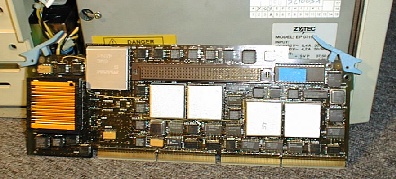
Click here or click onto the photo for
a full size version of this picture.
The Models 90 and 95 share the concept of a 'Processor Complex', a special card that carries the processor and a large part of the system logic like DMA and Synchrostream in later systems. All in all, there were five different types of complexes with several subvariants ranging from a 386DX20 to a Pentium-90. This is the so-called 'Type 1' complex with a 66 MHz DX2 CPU. The brown connector allows to add a 256Kbyte L2 cache module.

Click here or click onto the photo for
a full size version of this picture.
The power supply can simply be swung out of the machine by loosening the large blue screw. This is for example necessary for adding or removing memory modules. 8 SIMM sockets is a nice number...
- Processor:
- Intel i486DX2 @ 66 MHz (upgrade),
Intel i486DX @ 33MHz (original) - Coprocessor:
- integrated into CPU
- Cache:
- 8K internally in CPU, optional 256K L2 Cache Module
- Memory:
- 48 Mbytes (options range from 8M to 64M)
- Bus:
- 8 MCA slots (32 bit)
- Interfaces (onboard):
-
- Mouse, Keyboard
- 1 x Serial
- 1 x Parallel
- Floppy (1.44M), allows attachment of up to 3(!) drives
- Add-on cards:
-
- IBM LAN Adapter/A for Ethernet
- IBM XGA Graphics Adapter
- IBM Realtime Interface Coprocessor
- IBM SCSI Controller with Cache(512K)
- IBM 16/4 Token Ring Adapter
- Operating System(s):
-
- Caldera OpenDOS 7.01
- OS/2 Warp 3
- Linux 2.2 (Slackware-based)
- Useful Links: